TPMS TOYOTA COROLLA HATCHBACK 2020 Warranties & Maintenance Guides (in English)
[x] Cancel search | Manufacturer: TOYOTA, Model Year: 2020, Model line: COROLLA HATCHBACK, Model: TOYOTA COROLLA HATCHBACK 2020Pages: 260, PDF Size: 8.54 MB
Page 130 of 260
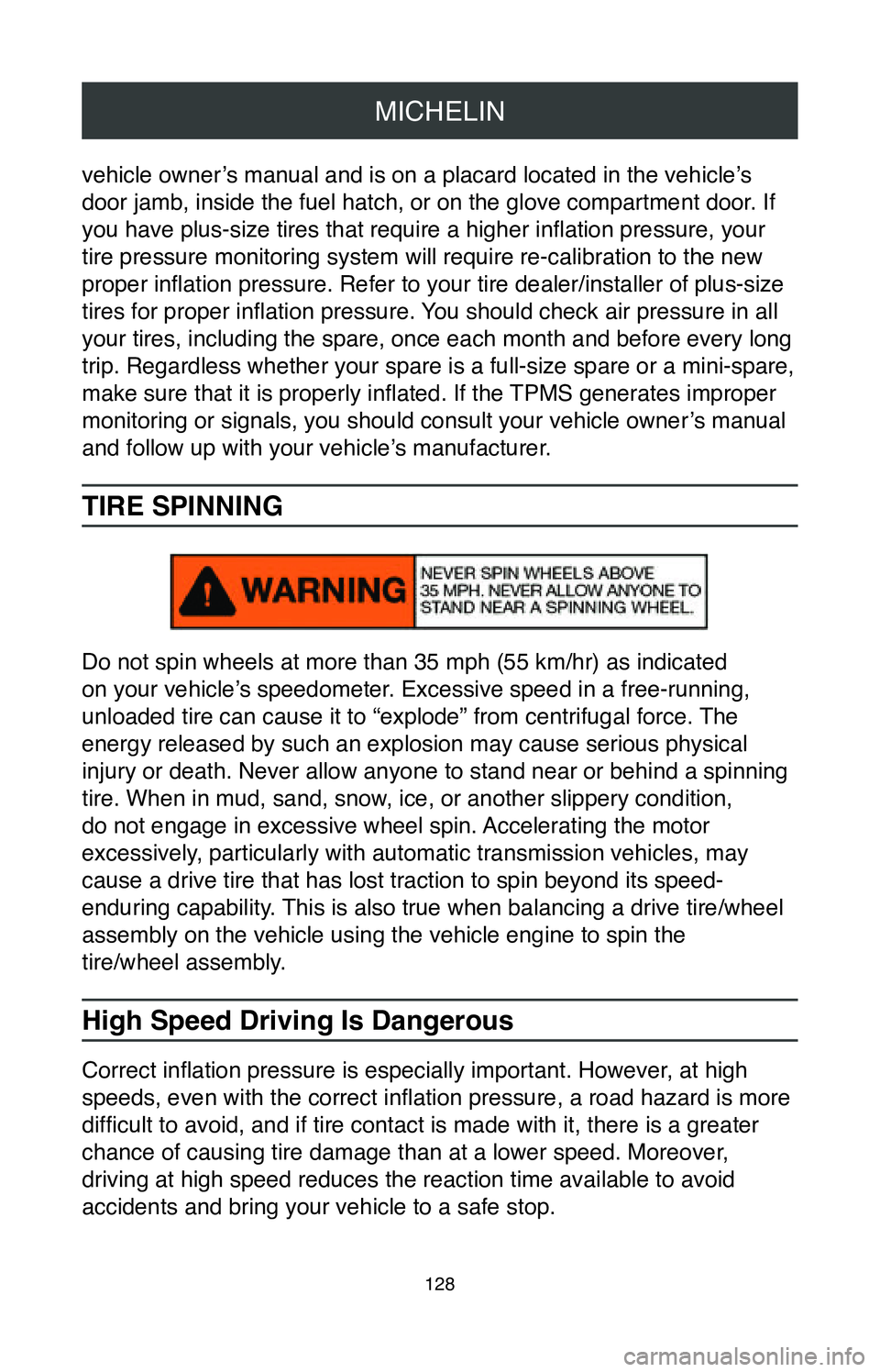
MICHELIN
128
vehicle owner’s manual and is on a placard located in the vehicle’s
door jamb, inside the fuel hatch, or on the glove compartment door. If
you have plus-size tires that require a higher inflation pressure, your
tire pressure monitoring system will require re-calibration to the new
proper inflation pressure. Refer to your tire dealer/installer of plus-size
tires for proper inflation pressure. You should check air pressure in all
your tires, including the spare, once each month and before every long
trip. Regardless whether your spare is a full-size spare or a mini-spare,
make sure that it is properly inflated. If the TPMS generates improper
monitoring or signals, you should consult your vehicle owner’s manual
and follow up with your vehicle’s manufacturer.
TIRE SPINNING
Do not spin wheels at more than 35 mph (55 km/hr) as indicated
on your vehicle’s speedometer. Excessive speed in a free-running,
unloaded tire can cause it to “explode” from centrifugal force. The
energy released by such an explosion may cause serious physical
injury or death. Never allow anyone to stand near or behind a spinning
tire. When in mud, sand, snow, ice, or another slippery condition,
do not engage in excessive wheel spin. Accelerating the motor
excessively, particularly with automatic transmission vehicles, may
cause a drive tire that has lost traction to spin beyond its speed-
enduring capability. This is also true when balancing a drive tire/wheel
assembly on the vehicle using the vehicle engine to spin the
tire/wheel assembly.
High Speed Driving Is Dangerous
Correct inflation pressure is especially important. However, at high
speeds, even with the correct inflation pressure, a road hazard is more
difficult to avoid, and if tire contact is made with it, there is a greater
chance of causing tire damage than at a lower speed. Moreover,
driving at high speed reduces the reaction time available to avoid
accidents and bring your vehicle to a safe stop.
Page 138 of 260
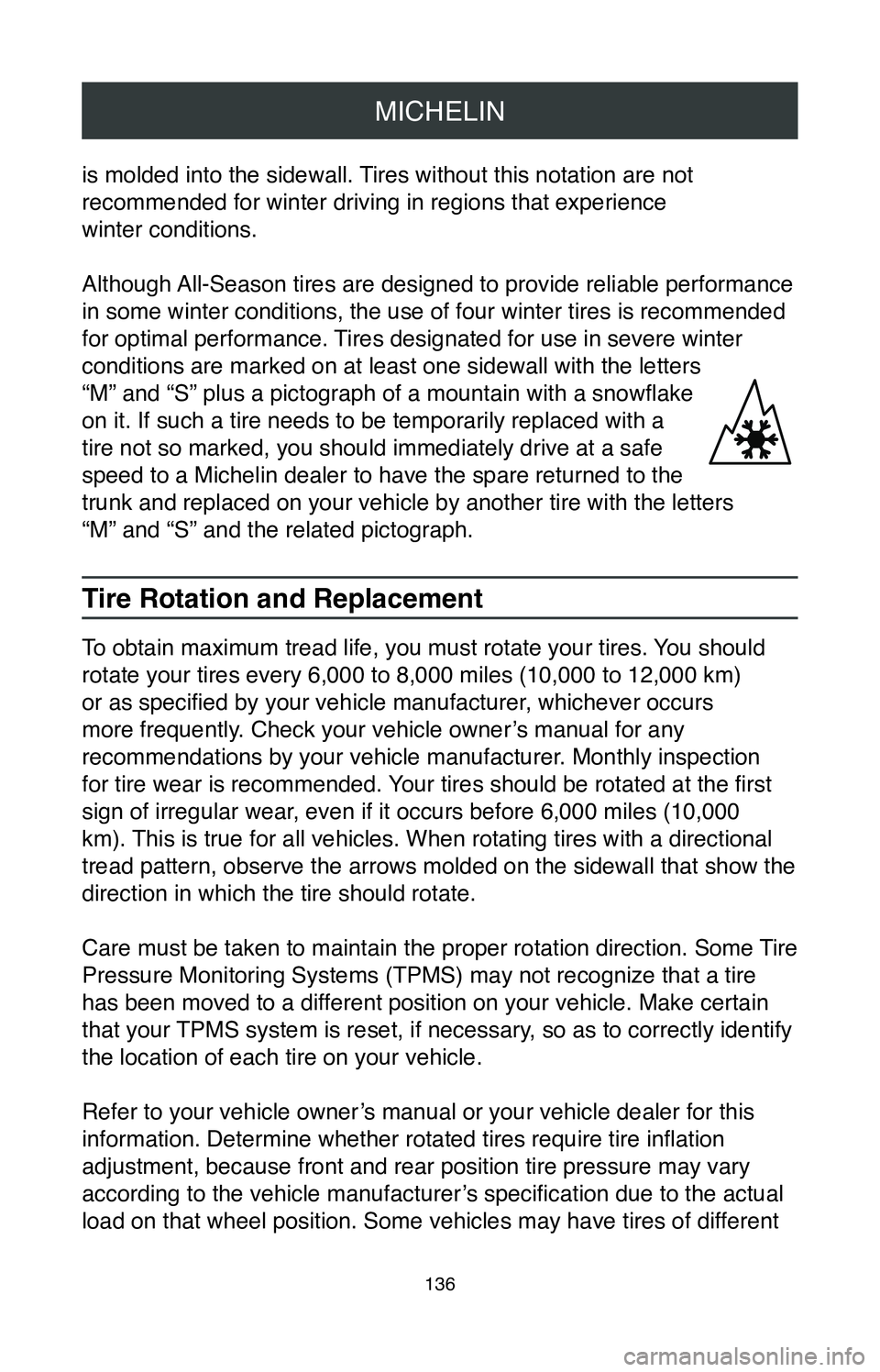
MICHELIN
136
is molded into the sidewall. Tires without this notation are not
recommended for winter driving in regions that experience
winter conditions.
Although All-Season tires are designed to provide reliable performance
in some winter conditions, the use of four winter tires is recommended
for optimal performance. Tires designated for use in severe winter
conditions are marked on at least one sidewall with the letters
“M” and “S” plus a pictograph of a mountain with a snowflake
on it. If such a tire needs to be temporarily replaced with a
tire not so marked, you should immediately drive at a safe
speed to a Michelin dealer to have the spare returned to the
trunk and replaced on your vehicle by another tire with the letters
“M” and “S” and the related pictograph.
Tire Rotation and Replacement
To obtain maximum tread life, you must rotate your tires. You should
rotate your tires every 6,000 to 8,000 miles (10,000 to 12,000 km)
or as specified by your vehicle manufacturer, whichever occurs
more frequently. Check your vehicle owner’s manual for any
recommendations by your vehicle manufacturer. Monthly inspection
for tire wear is recommended. Your tires should be rotated at the first
sign of irregular wear, even if it occurs before 6,000 miles (10,000
km). This is true for all vehicles. When rotating tires with a directional
tread pattern, observe the arrows molded on the sidewall that show the
direction in which the tire should rotate.
Care must be taken to maintain the proper rotation direction. Some Tire
Pressure Monitoring Systems (TPMS) may not recognize that a tire
has been moved to a different position on your vehicle. Make certain
that your TPMS system is reset, if necessary, so as to correctly identify
the location of each tire on your vehicle.
Refer to your vehicle owner’s manual or your vehicle dealer for this
information. Determine whether rotated tires require tire inflation
adjustment, because front and rear position tire pressure may vary
according to the vehicle manufacturer’s specification due to the actual
load on that wheel position. Some vehicles may have tires of different
Page 160 of 260
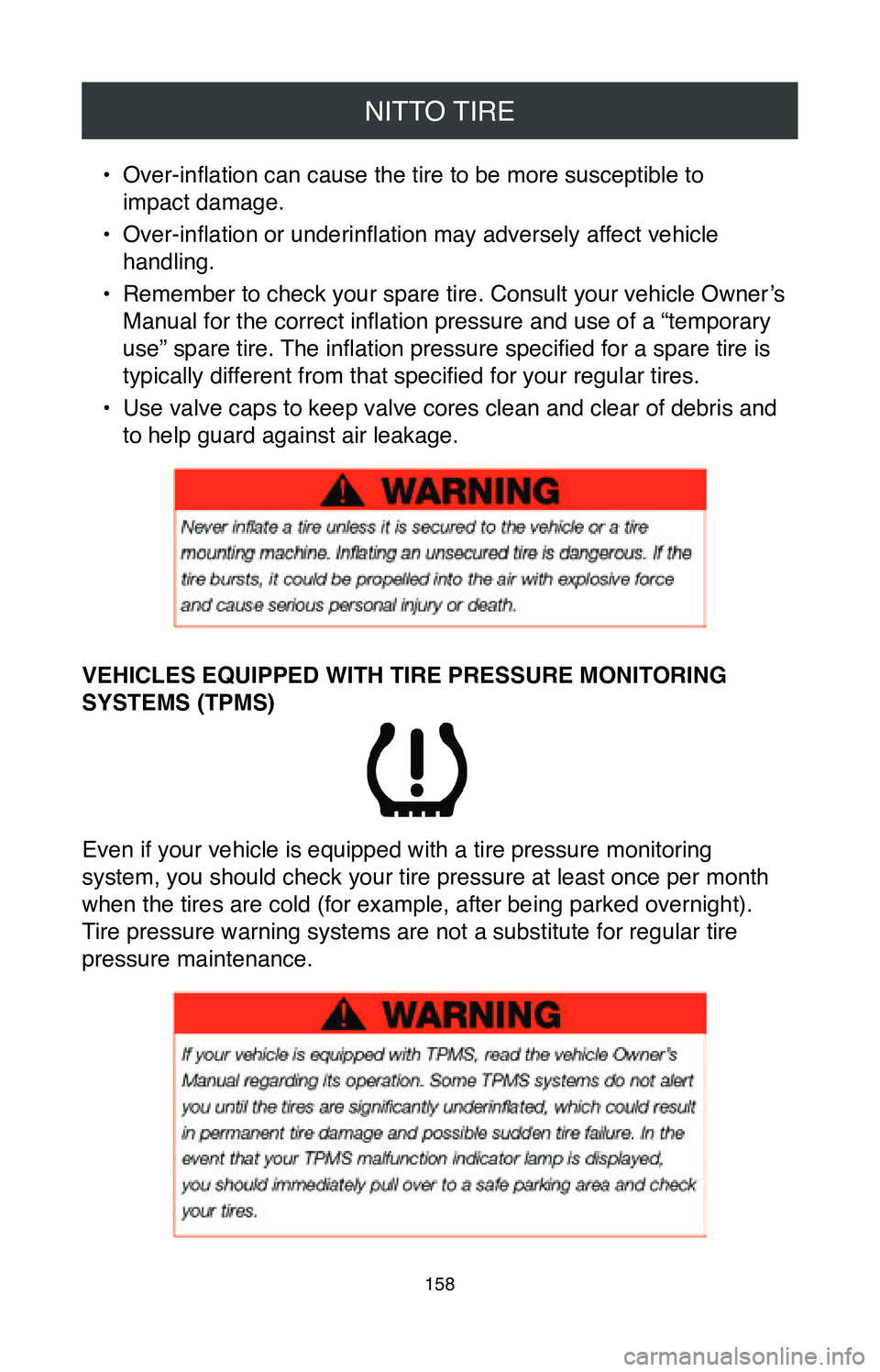
NITTO TIRE
158
• Over-inflation can cause the tire to be more susceptible to
impact damage.
•
Over-inflation or underinflation may adversely affect vehicle
handling.
•
Remember to check your spare tire. Consult your vehicle Owner’s
Manual for the correct inflation pressure and use of a “temporary
use” spare tire. The inflation pressure specified for a spare tire is
typically different from that specified for your regular tires.
•
Use valve caps to keep valve cores clean and clear of debris and
to help guard against air leakage.
VEHICLES EQUIPPED WITH TIRE PRESSURE MONITORING
SYSTEMS (TPMS)
Even if your vehicle is equipped with a tire pressure monitoring
system, you should check your tire pressure at least once per month
when the tires are cold (for example, after being parked overnight).
Tire pressure warning systems are not a substitute for regular tire
pressure maintenance.
Page 202 of 260
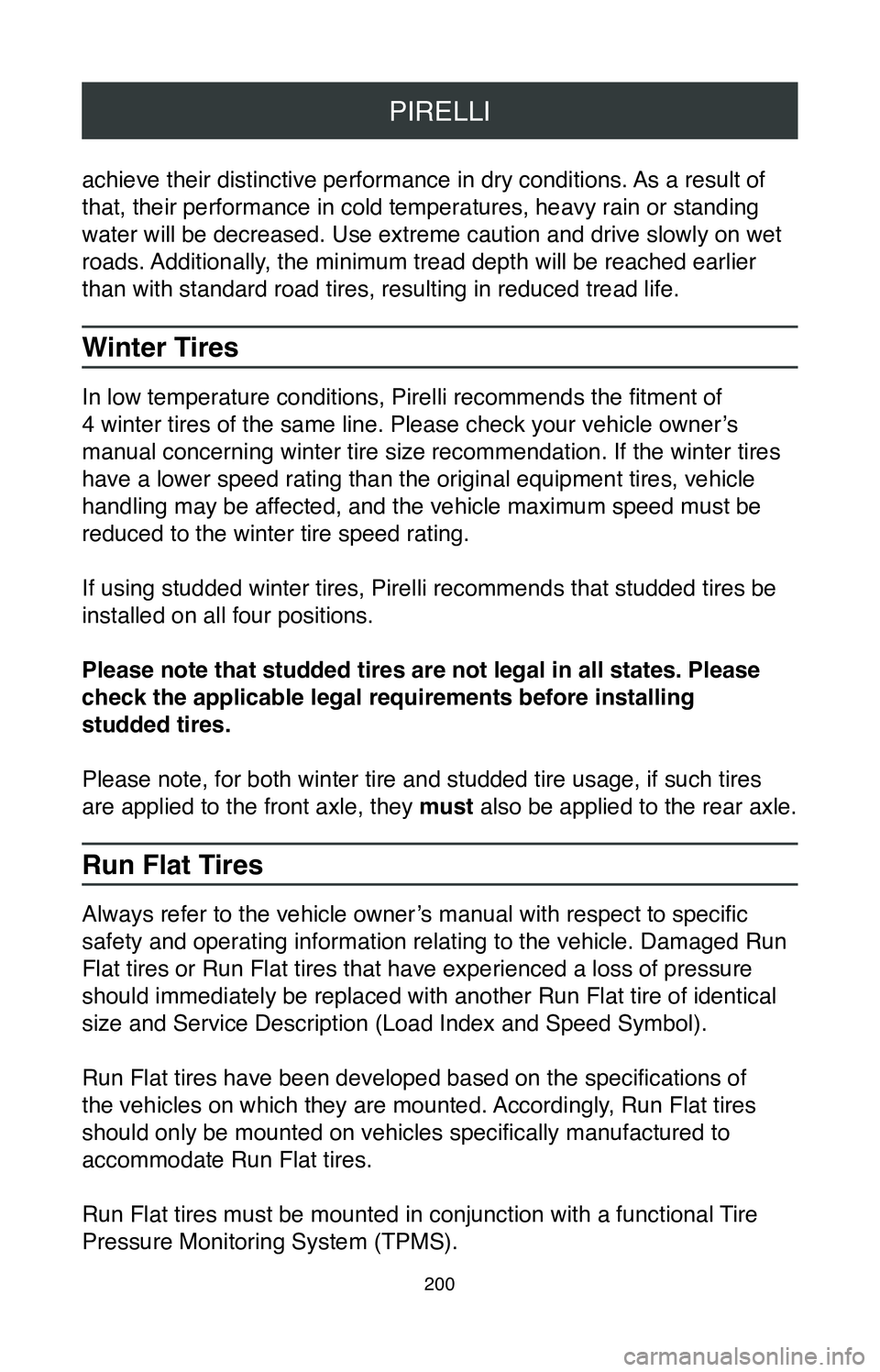
PIRELLI
200
achieve their distinctive performance in dry conditions. As a result of
that, their performance in cold temperatures, heavy rain or standing
water will be decreased. Use extreme caution and drive slowly on wet
roads. Additionally, the minimum tread depth will be reached earlier
than with standard road tires, resulting in reduced tread life.
Winter Tires
In low temperature conditions, Pirelli recommends the fitment of
4 winter tires of the same line. Please check your vehicle owner’s
manual concerning winter tire size recommendation. If the winter tires
have a lower speed rating than the original equipment tires, vehicle
handling may be affected, and the vehicle maximum speed must be
reduced to the winter tire speed rating.
If using studded winter tires, Pirelli recommends that studded tires be \
installed on all four positions.
Please note that studded tires are not legal in all states. Please
check the applicable legal requirements before installing
studded tires.
Please note, for both winter tire and studded tire usage, if such tires \
are applied to the front axle, they must also be applied to the rear axle.
Run Flat Tires
Always refer to the vehicle owner’s manual with respect to specific
safety and operating information relating to the vehicle. Damaged Run
Flat tires or Run Flat tires that have experienced a loss of pressure
should immediately be replaced with another Run Flat tire of identical
size and Service Description (Load Index and Speed Symbol).
Run Flat tires have been developed based on the specifications of
the vehicles on which they are mounted. Accordingly, Run Flat tires
should only be mounted on vehicles specifically manufactured to
accommodate Run Flat tires.
Run Flat tires must be mounted in conjunction with a functional Tire
Pressure Monitoring System (TPMS).
Page 203 of 260
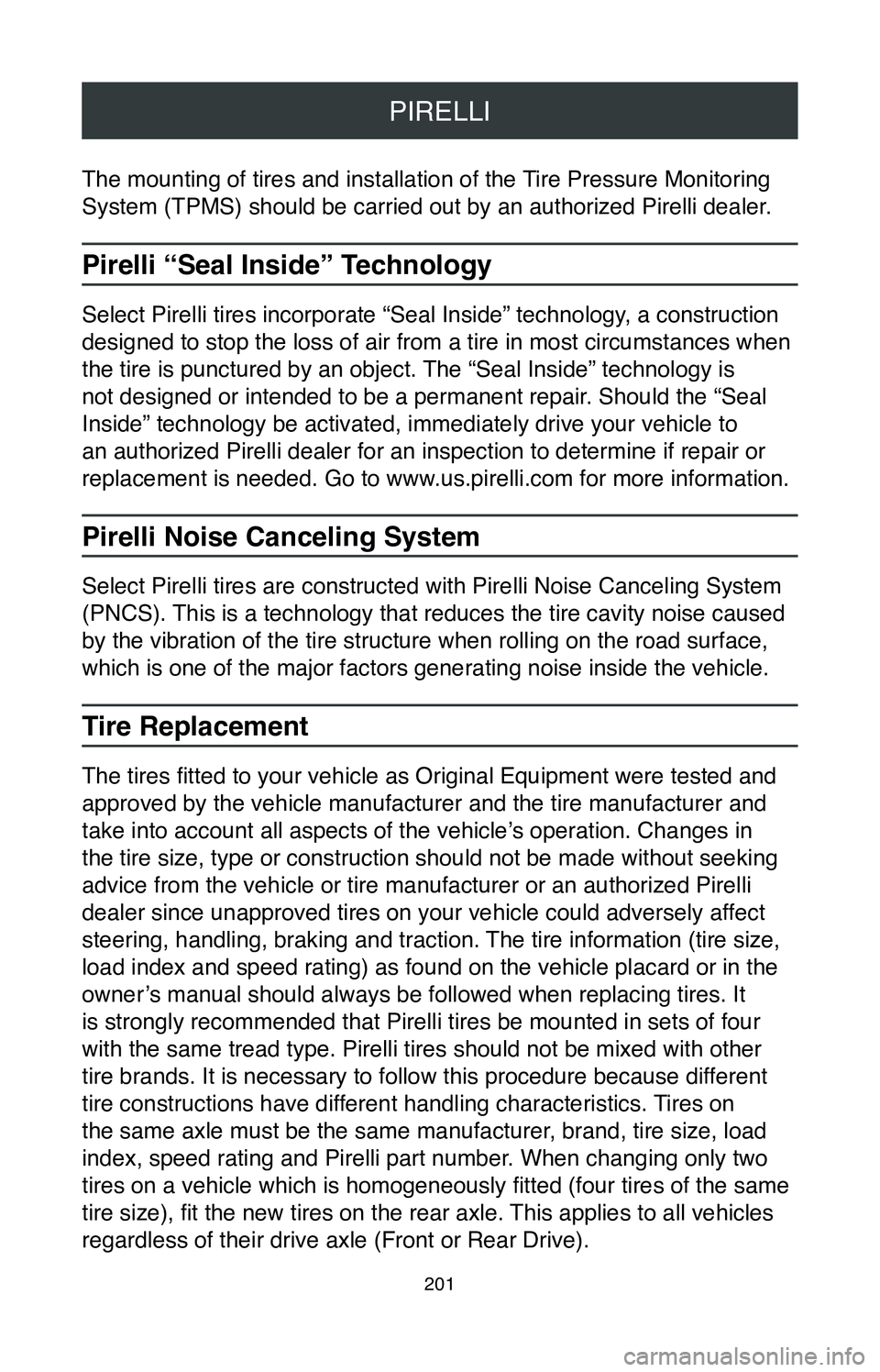
PIRELLI
201
The mounting of tires and installation of the Tire Pressure Monitoring
System (TPMS) should be carried out by an authorized Pirelli dealer.
Pirelli “Seal Inside” Technology
Select Pirelli tires incorporate “Seal Inside” technology, a construction
designed to stop the loss of air from a tire in most circumstances when \
the tire is punctured by an object. The “Seal Inside” technology is
not designed or intended to be a permanent repair. Should the “Seal
Inside” technology be activated, immediately drive your vehicle to
an authorized Pirelli dealer for an inspection to determine if repair or\
replacement is needed. Go to www.us.pirelli.com for more information.
Pirelli Noise Canceling System
Select Pirelli tires are constructed with Pirelli Noise Canceling System\
(PNCS). This is a technology that reduces the tire cavity noise caused
by the vibration of the tire structure when rolling on the road surface,\
which is one of the major factors generating noise inside the vehicle.
Tire Replacement
The tires fitted to your vehicle as Original Equipment were tested and
approved by the vehicle manufacturer and the tire manufacturer and
take into account all aspects of the vehicle’s operation. Changes in
the tire size, type or construction should not be made without seeking
advice from the vehicle or tire manufacturer or an authorized Pirelli
dealer since unapproved tires on your vehicle could adversely affect
steering, handling, braking and traction. The tire information (tire size,
load index and speed rating) as found on the vehicle placard or in the \
owner’s manual should always be followed when replacing tires. It
is strongly recommended that Pirelli tires be mounted in sets of four
with the same tread type. Pirelli tires should not be mixed with other
tire brands. It is necessary to follow this procedure because different
tire constructions have different handling characteristics. Tires on
the same axle must be the same manufacturer, brand, tire size, load
index, speed rating and Pirelli part number. When changing only two
tires on a vehicle which is homogeneously fitted (four tires of the same
tire size), fit the new tires on the rear axle. This applies to all vehicles
regardless of their drive axle (Front or Rear Drive).
Page 219 of 260
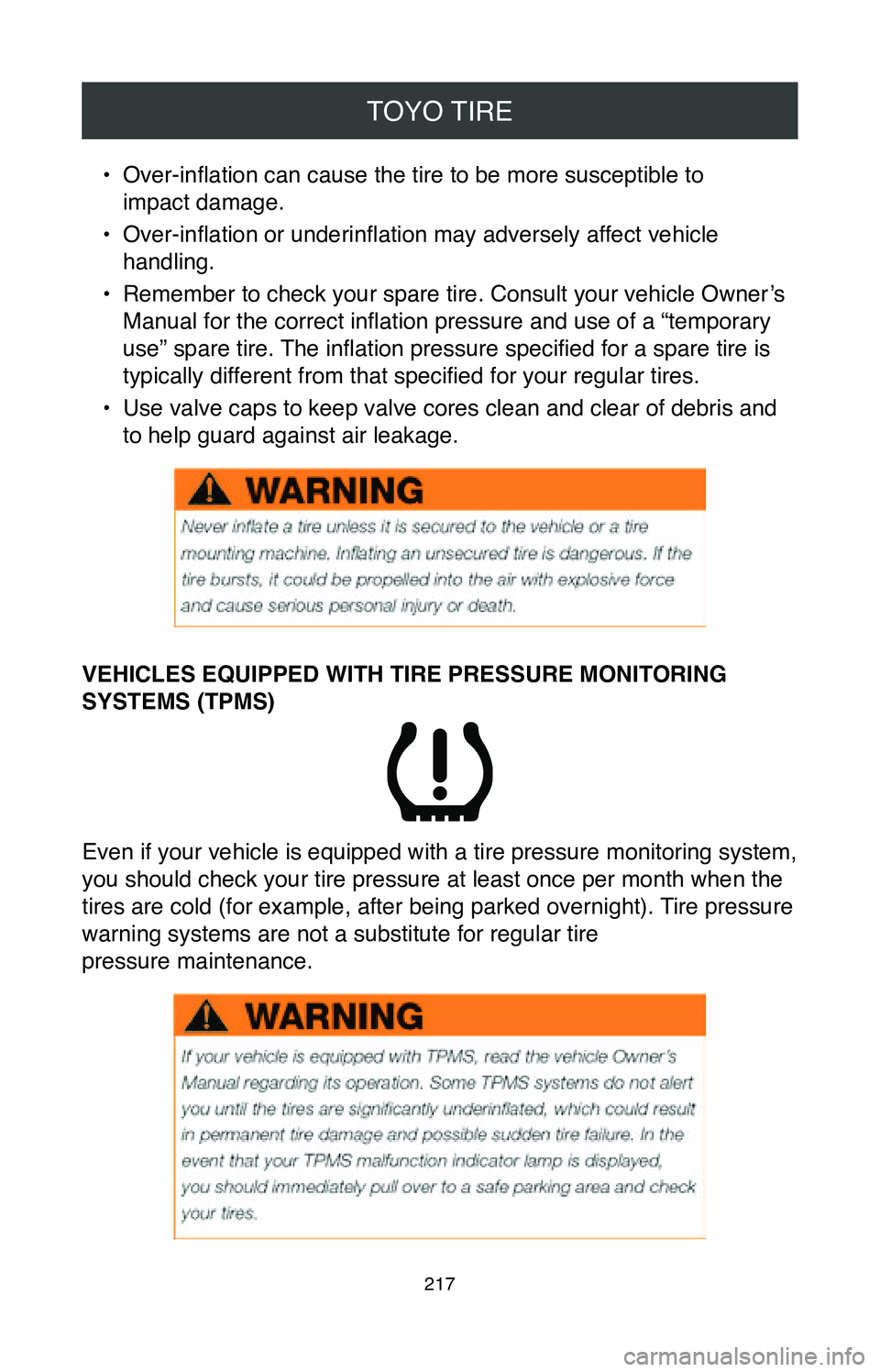
TOYO TIRE
217
• Over-inflation can cause the tire to be more susceptible to
impact damage.
•
Over-inflation or underinflation may adversely affect vehicle
handling.
•
Remember to check your spare tire. Consult your vehicle Owner’s
Manual for the correct inflation pressure and use of a “temporary
use” spare tire. The inflation pressure specified for a spare tire is
typically different from that specified for your regular tires.
•
Use valve caps to keep valve cores clean and clear of debris and
to help guard against air leakage.
VEHICLES EQUIPPED WITH TIRE PRESSURE MONITORING
SYSTEMS (TPMS)
Even if your vehicle is equipped with a tire pressure monitoring system,\
you should check your tire pressure at least once per month when the
tires are cold (for example, after being parked overnight). Tire pressure
warning systems are not a substitute for regular tire
pressure maintenance.